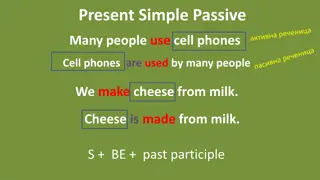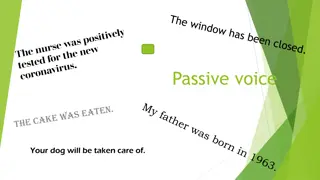Introduction to Passive Movement in Physical Therapy
Passive movement in physical therapy involves movements generated by external forces, such as therapists or machines, for patients unable to move actively due to various conditions. The practice aims to prevent complications from immobilization and maintain joint health and tissue mobility. Passive movement also has additional uses in assessing joint structures, demonstrating exercises, and preparing for stretching, with some limitations in certain scenarios.
Download Presentation

Please find below an Image/Link to download the presentation.
The content on the website is provided AS IS for your information and personal use only. It may not be sold, licensed, or shared on other websites without obtaining consent from the author.If you encounter any issues during the download, it is possible that the publisher has removed the file from their server.
You are allowed to download the files provided on this website for personal or commercial use, subject to the condition that they are used lawfully. All files are the property of their respective owners.
The content on the website is provided AS IS for your information and personal use only. It may not be sold, licensed, or shared on other websites without obtaining consent from the author.
E N D
Presentation Transcript
Definition Passive movement are those movement which are produced by an external force. External forces may be manual that is the therapist, the other parts of patient s own body or mechanical with the help of machines.
Ex. OF MANUAL & MECHANICAL PASSIVE MOVEMENT
Indications of Passive movement Passive movement can be given in the following conditions: - when a patient is not able to or not suppose to actively move a segment of the body as, -when commatose -when paralysed -on complete bed rest -in post operative patients following arthroscopy,joint replacement etc.
Goals of passive movement The primary goal for passive movement is to decrease the complications that occur with immobilisation such as, -cartilage degeneration -adhesion formation -contracture formation -sluggish circulation etc.
Effects & uses of Passive movement -To maintain joint & connective tissue mobility -To minimize the effects of formation of contracture -To maintain mechanical elasticity of muscles -To assist circulation -To enhance synovial fluid movement for cartilage nutrition -To assist the healing process -To promote relaxation & reduce pain -To assist the lymphatic drainage -To make the patient aware of movement -To maintain healthy,efficient gliding of skin , fascia,muscles,tendon,nerves,blood vessels & joint surfaces.
Other uses of passive movement 1- When a therapist is examining inert structures of joints passive movement is used to determine: -the limitation of movement -the joint stability -the muscles & soft tissues elasticity 2- When a therapist is teaching an active exercise programme passive movement is used to demonstrate the desired movement 3- exercises. When a therapist is preparing a patient for stretching
Disadvantages or limitations of passive movement True passive, relaxed ROM may be difficult to obtain when muscles is innervated & the patient is conscious. Passive movement will not - prevent muscle atrophy - increase muscle strength or endurance - assist circulation to the extent that active voluntary muscles contraction does.
Contraindications - Joint pain & inflammation - Joint effusion - Infection or fever - In case of muscle spasm - In case of fracture - In case of venous stasis or thrombosis
Classification 1- Relaxed passive movement including Accessory movement: a) Relaxed passive movement: These are movement performed accurately & smoothly by the physiotherapist in the same range & direction as active movement. The joint should be moved in the existing ROM & within the pain limit.
b) Accessory movement: These occurs as a part of any normal joint movement but may be limited or absent in abnormal joint conditions. It consists of gliding or rotational movement which can t be performed in isolation as voluntary movement but can be isolated by the therapist.
2- Passive manual mobilization techniques: a) Mobilization of joints: -These are usually small, repetitive, rhythmical, oscillatory, localised accessory or functional movement performed by the therapist. -These can be done gently or strongly according to the condition in various small amplitude within the available range under the control of therapist.
b) Manipulation:- By physiotherapist: -These are accurately localised, single, quick movement of small amplitude & high velocity completed before the patient can stop it. By surgeon: -The movement are performed under anaesthesia by a surgeon to gain further range. 3- Controlled sustained stretching of tightened structures: Passive stretching of muscles & other soft tissues can be given to increase ROM.
Principles -Relaxation:- Communicate with the patient. The movement which has to be given & its effects should be briefly explained to the patient. The selection of suitable starting position ensures comfort & support & counselling by physiotherapist will inspire confidence & co-operation in maintaining relaxation through out the movement. -Fixation:- When movement is to be limited to a specific joint, the bone which lies proximal to it is fixed by the physiotherapist as close to the joint line as possible to ensure that the movement is localised to that joint.
Support:- Full & comfortable support is given to the part to be moved, so that the patient has confidence & will remain relaxed. The physiotherapist grasps the part firmly but comfortably or it may be supported by axial suspension in slings for trunk & heavy limbs as it freeze the therapist s hand to assist fixation & to perform movement. Traction:- Many joints allow the articular surfaces to be drawn apart by traction which is always given in long axis of joints. Traction is thought to facilitate the movement by reducing the interarticular friction.
-Range:- The ROM is as full as the condition of the joint permits without eliciting pain & spasm in the surrounding structures. -Speed & Duration:- The speed must be uniform, fairly slow & rythmical. The number of times the movement is performed depends upon the purpose for which it is used.
Procedures for applying PROM techniques Examination, Evaluation & Re-Planning- -Examine & evaluate the patient s impairments & level of function, determine any precaution & then plan the treatment. -Determine the ability of the patient to participate in the ROM activity.
-Determine the amount of motion that can be safely applied for the condition of the tissues & health of the individual. -Monitor the patient s general condition & responses during & after the examination & intervention. Note any change in vital signs, any change in the warmth & colour of the segment & any change in the ROM, pain or quality of movement
Preparation of the patient- -Free the region from restrictive clothing, splints & dressing. Drop the patient as necessary. -Position the patient in a comfortable starting position with proper body alignment & stabilization that will allow you to move the segment through the available ROM. -Position yourself so that proper movement can be given easily.























